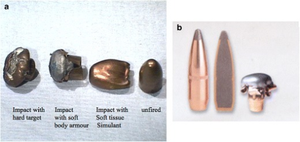We need you! Join our contributor community and become a WikEM editor through our open and transparent promotion process.
Gun shot wounds
From WikEM
Contents
Background
- Bullets
- Lead alloy
- Full metal or partial metal jacket around lead core
- Tip variation (pointed, flat, hollow, soft)
- General caliber classification
- Small (.22, .25)
- Medium (.32, .38, .357, 9mm)
- Large (.40, .41, .44, .45, .50)
- Common shotgun gauges
- 12-gauge = bore diameter of .729 inches
- 20-gauge = .615 inches
- Shotgun pellets, small to large
- Birdshot (shotshells) - many small pellets, large kill spread
- Buckshot - fewer pellets, larger pellets
- Slug, sabots - single large solid slug
Types
High Velocity Bullets
- Examples: M-16 or 30/06 Springfield
- Very high kinetic energy
- Little deformity when fired
- Cavitation is principle mechanism of destruction, the dissipation of energy radially away from the bullet as it travels through tissue
- Large zone of tissue injury even away from tract
Low Velocity Bullets
- Examples: .22 long rifle or .45 pistol
- Relatively low kinetic energy
- Deform from friction
- Crash injury is principle mechanism of damage given projectile tumbling and fragmentation
Shotgun
- Very high kinetic energy at close range
- Shells contain several to several hundred hundred pellets
- Spread of pellets and rapid energy transfer makes these weapons dangerous at close range
Clinical Features
- Assess for entrance and exit wound
- Exit wound may not follow logical trajectory
- May be absent, especially with low velocity GSWs
- Strongly consider not documenting "entrance" vs. "exit" given medicolegal implications if not completely sure
- Missiles refer to fragments of bone or other tissue, secondary to the bullet
- Refer to specific systems for additional information
- Entrance
- Round, punched out hole
- Marginal abrasion or abrasion ring
- +/- fouling (soot)
- +/- stippling (punctate abrasions from gunpowder impact)
- Exit
- Usually larger (except head)
- Wound edges may be reapproximated
- No marginal abrasion
- Slit-like, stellate, circular
- Irregular due to loss of kinetic energy, bullet deformation, yaw
- Range of fire
- Contact - < 12 in, fouling/soot, muzzle stamp (tight contact)
- Intermediate - 2.5-3.5 ft, +/- fouling, stippling
- Distant - > 3.5 ft, marginal abrasion only
- Shotgun extrance wounds
- Marginal abrasion, fouling, stippling
- Plastic wad found in body in range < 5-10 ft
- Close range < 12 inches with ~1 inch diameter single hole with fouling
- 3 ft - round hole, scalloped edges, stippling
- 4 ft - round hole, scalloping, satellites
- Distant (> 10 ft) - pellet spread
Region Specific Information
- Head Trauma (Main)
- Penetrating neck trauma
- Cardiac Trauma
- Diaphragm Injury
- Abdominal Trauma
- Open Fracture
- Spinal Trauma (Main)
Evaluation
- ATLS/FAST/Trauma Labs
- CT Scan as needed depending on location
- X-ray if bony injury suspected
- CTA if vascular injury suspected
Management
- Trauma consult depending on location and extent of wound
- Ortho consult for bony injuries
- Neuro/OMF/ENT as needed
- Removal if intraarticular, with case reports of lead toxicity[1]
Prophylactic Antibiotics
- Infection after gunshot injury is a rare complication
- No prophylactic antibiotics for:[2]
- Soft tissue gun shot wounds
- Non-operative fractures caused by gun shot wounds
- Give prophylactic for:[3]
- Intra-articular fracture (any type of gun shot wound)
- Fractures caused by high-velocity weapons or shotguns
- Penetration through contaminated hollow viscous (passage through bowel)[4]
Disposition
- To OR if significant injuries
- Admission/Obs for less concerning injuries
- Minor injuries may be discharged
- GSW Protocol allows lower extremity wounds to be discharged from ED after 9 hours without invasive imaging if they have normal ABIs[5]
See Also
References
- ↑ Lu K et al. Approach to Management of Intravascular Missile Emboli: Review of the Literature and Case Report. West J Emerg Med. 2015 Jul; 16(4): 489–496.
- ↑ Hot bullet, Dirty Wound? http://wueverydayebm.blogspot.com/2015/02/hot-bullet-dirty-wound.html
- ↑ Simpson, B. M., Wilson, R. H., & Grant, R. E. (2003). Antibiotic therapy in gunshot wound injuries. Clinical orthopaedics and related research, 408, 82-85.
- ↑ Lu K et al. Approach to Management of Intravascular Missile Emboli: Review of the Literature and Case Report. West J Emerg Med. 2015 Jul; 16(4): 489–496.
- ↑ Sandjadi, Javid. Expedited treatment of lower extremity gunshot wounds.

